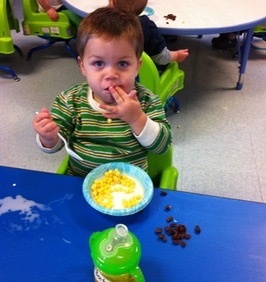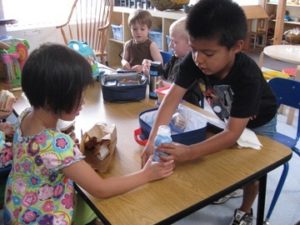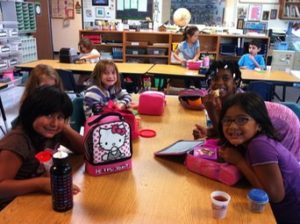 One of the most significant aspects of the school focused on food is lunch. Since the Seed’s beginning, children have brought their own lunches. We do this to honor the food habits and traditions of each family, individual nutritional preferences of each child, and to keep the lunch process as simple as possible for our staff. We have always made suggestions and offered guidelines to parents, and in the end serve whatever is available in each child’s lunchbox. Our revised lunch practice will continue with a few adjustments based on recommended best practices from (http://www.naeyc.org/files/naeyc/Eliassen_0.pdf) and a commitment to creating a consistent school-wide lunch policy. See the Seed Food Policy for further information. Here is our revised lunch policy developed for each grade level group:
One of the most significant aspects of the school focused on food is lunch. Since the Seed’s beginning, children have brought their own lunches. We do this to honor the food habits and traditions of each family, individual nutritional preferences of each child, and to keep the lunch process as simple as possible for our staff. We have always made suggestions and offered guidelines to parents, and in the end serve whatever is available in each child’s lunchbox. Our revised lunch practice will continue with a few adjustments based on recommended best practices from (http://www.naeyc.org/files/naeyc/Eliassen_0.pdf) and a commitment to creating a consistent school-wide lunch policy. See the Seed Food Policy for further information. Here is our revised lunch policy developed for each grade level group:
 TODDLERS
TODDLERS
At the toddler level, lunch is a time for:
– practicing social and self-help skills (e.g. use a spoon, indicate when they are “all done”)
– enjoying new and favorite foods
– learning how to sit at the table
• Teachers make all items in the lunchbox available to the children at once so they can choose to eat their food in any order.
• Toddler 1s are given a sample of each item in their lunchbox until we can be certain that they will keep their lunch containers on the table. Some eat their food directly off of the sanitized table surface, while others are mastering feeding themselves with a utensil from a small container. At the beginning of the year, some toddlers need help with feeding. Gradually everyone in the class can eat independently.
• Per parental request, some food items may be heated in the classroom microwave oven. Most items are served cold or at room temperature. Toddler lunchboxes and drinks are stored in the refrigerator before and after lunch. Some toddlers eat remaining lunch items after their naps if they are staying for the after school program.
 PRESCHOOL
PRESCHOOL
At the preschool level, lunch is a time for:
– learning and practicing appropriate social interaction (e.g. voice volume)
– encouraging friendliness and inclusion (e.g. scooting over to make room for another child)
– building language skills through mealtime conversation (e.g. asking for things, having a conversation while eating)
– applying manners
• Preschoolers are given their entire lunchbox and have access to all food items in any order during the lunch period. At first, younger children may need help opening containers, but they generally master this with practice.
• Preschoolers are taught to clean up after themselves, put their containers and lunchbox away, and discard any scraps or trash.
• Lunches require an icepack to keep items cool in the classroom lunch bin. A small refrigerator is available for students to store drinks such as milk, as well as all-class snack items. Microwaves are not available in Preschool classrooms, therefore food items that children would like warm should be stored in a thermos or other insulated container.
 ELEMENTARY
ELEMENTARY
At the Elemtary level, lunch is a time for:
– continuing to practice appropriate social skills
– encouraging friendliness and inclusion (e.g. scooting over to make room for another child)
– practicing table manners (e.g. chewing with your mouth closed, reserving comments about other students’ lunches, keeping feet off the table)
– being responsible for cleaning up (e.g. both personal items and taking turns with sweeping, cleaning tables)
• Elementary students are given their entire lunchbox and have access to all food items in any order during the snack and lunch period.
• Lunches require an icepack to keep items cool in the classroom lunch bin, as there is no refrigerator in the elementary classrooms. Microwaves are not available for elementary students; therefore, food items that children would like warm should be stored in a thermos or other insulated container.
(see separate section on for lunch ideas)
© MARY K GLOVER 2014
